新人教版英语八年级下unit 2教学案
人教版初中八年级英语下册第二单元Unit 2 教案含教学反思
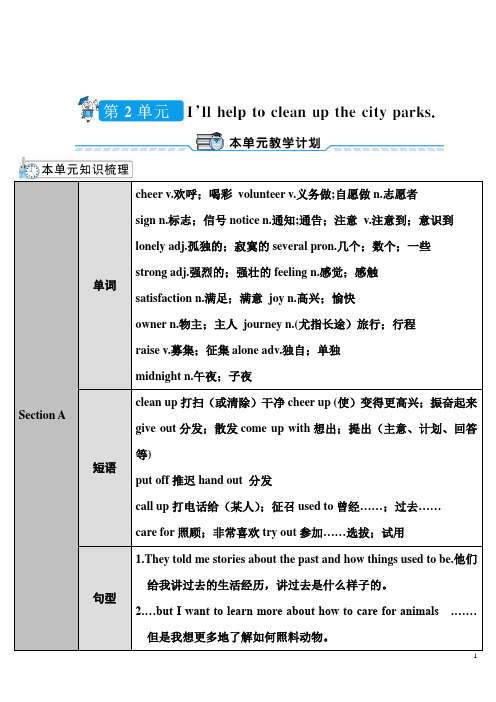
Section A 单词cheer v.欢呼;喝彩volunteer v.义务做;自愿做n.志愿者sign n.标志;信号notice n.通知;通告;注意v.注意到;意识到lonely adj.孤独的;寂寞的several pron.几个;数个;一些strong adj.强烈的;强壮的feeling n.感觉;感触satisfaction n.满足;满意joy n.髙兴;愉快owner n.物主;主人journey n.(尤指长途)旅行;行程raise v.募集;征集alone adv.独自;单独midnight n.午夜;子夜短语clean up打扫(或清除)干净cheer up (使)变得更高兴;振奋起来give out分发;散发come up with想出;提出(主意、计划、回答等)put off推迟hand out 分发call up打电话给(某人);征召used to曾经……;过去……care for照顾;非常喜欢try out参加……选拔;试用句型1.They told me stories about the past and how things used to be.他们给我讲过去的生活经历,讲过去是什么样子的。
2.…but I want to learn more about how to care for animals.……但是我想更多地了解如何照料动物。
句型1.I’m sure you know that this group was set up to help disabled people like me.我确定你知道这个团体是为了帮助像我这样的残疾人而建立的。
2.You helped to make it possible for me to have Lucky.有了你的帮助,我才有可能拥有“幸运儿”。
3.I’ll send you a photo of him if you like,and I could show you how he helps me.如果你喜欢,我会把它的一张照片寄给你,并可以让你看看它是怎样帮助我的。
人教版八年级英语下册教案:Unit 2 第2课时
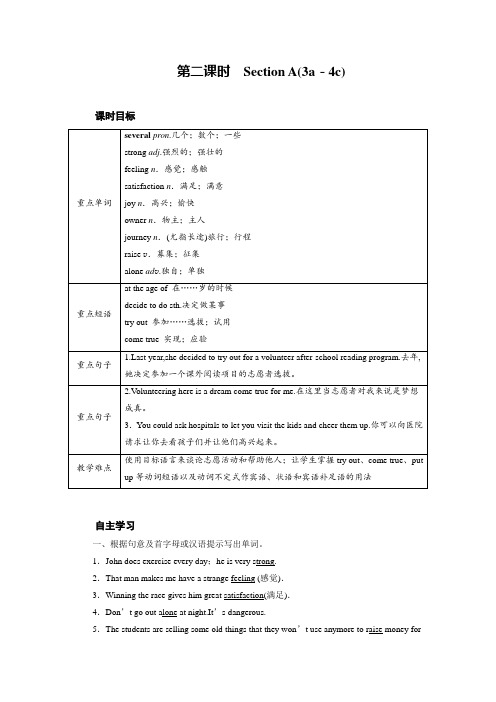
第二课时Section A(3a-4c)课时目标自主学习一、根据句意及首字母或汉语提示写出单词。
1.John does exercise every day;he is very strong.2.That man makes me have a strange feeling (感觉).3.Winning the race gives him great satisfaction(满足).4.Don’t go out alone at night.It’s dangerous.5.The students are selling some old things that they won’t use anymore to raise money forpoor children.二、写出下列画线短语的汉语意思。
1.She could read by herself at the age of four.在……岁的时候2.Mario loves animals and wants to be an animal doctor.兽医3.She decided to try out for a volunteer after-school reading program.参加……选拔;试用4.Volunteering here is a dream come true for me.实现5.I can do what I love to do and help others at the same time.同时教学过程环节1新课导入让学生听写以下短语,然后教师订正答案。
(教师可邀请两名学生到黑板前听写)打扫(或清除)干净________(使)变得高兴;振奋起来________分发;散发________想出;提出(注意、计划、回答等)________推迟________分发________打电话给(某人);征召________曾经……;过去……________照顾;非常喜欢________设计意图:温故知新,通过听写任务帮助学生记忆上堂课所学的短语,有利于知识间的衔接,便于老师循序渐进地开展教学。
人教版英语八年级下册Unit2《I’llhelptocleanupthecitypark》说课稿
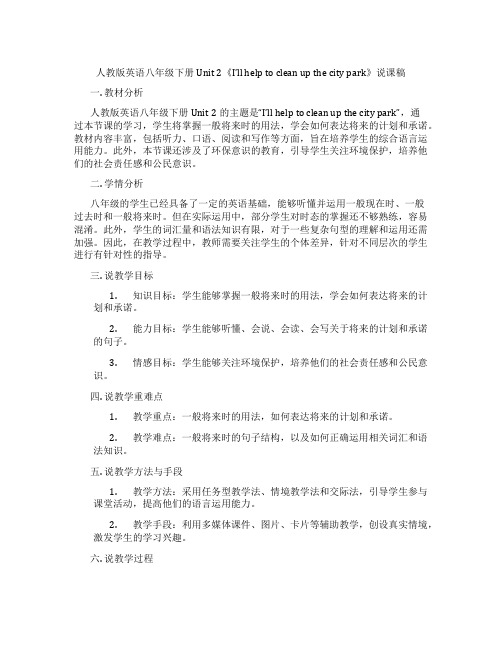
人教版英语八年级下册Unit 2《I’ll help to clean up the city park》说课稿一. 教材分析人教版英语八年级下册Unit 2的主题是“I’ll help to clean up the city park”,通过本节课的学习,学生将掌握一般将来时的用法,学会如何表达将来的计划和承诺。
教材内容丰富,包括听力、口语、阅读和写作等方面,旨在培养学生的综合语言运用能力。
此外,本节课还涉及了环保意识的教育,引导学生关注环境保护,培养他们的社会责任感和公民意识。
二. 学情分析八年级的学生已经具备了一定的英语基础,能够听懂并运用一般现在时、一般过去时和一般将来时。
但在实际运用中,部分学生对时态的掌握还不够熟练,容易混淆。
此外,学生的词汇量和语法知识有限,对于一些复杂句型的理解和运用还需加强。
因此,在教学过程中,教师需要关注学生的个体差异,针对不同层次的学生进行有针对性的指导。
三. 说教学目标1.知识目标:学生能够掌握一般将来时的用法,学会如何表达将来的计划和承诺。
2.能力目标:学生能够听懂、会说、会读、会写关于将来的计划和承诺的句子。
3.情感目标:学生能够关注环境保护,培养他们的社会责任感和公民意识。
四. 说教学重难点1.教学重点:一般将来时的用法,如何表达将来的计划和承诺。
2.教学难点:一般将来时的句子结构,以及如何正确运用相关词汇和语法知识。
五. 说教学方法与手段1.教学方法:采用任务型教学法、情境教学法和交际法,引导学生参与课堂活动,提高他们的语言运用能力。
2.教学手段:利用多媒体课件、图片、卡片等辅助教学,创设真实情境,激发学生的学习兴趣。
六. 说教学过程1.导入:通过展示城市公园的图片,引导学生谈论自己对公园的印象和感受,引出本节课的主题。
2.新课呈现:讲解一般将来时的用法,展示相关句子和例句,让学生感知和理解一般将来时的结构。
3.操练环节:通过听力练习、角色扮演、小组讨论等形式,让学生在实际语境中运用一般将来时。
2020年春人教新目标英语八年级下册Unit2全单元教案(无答案)
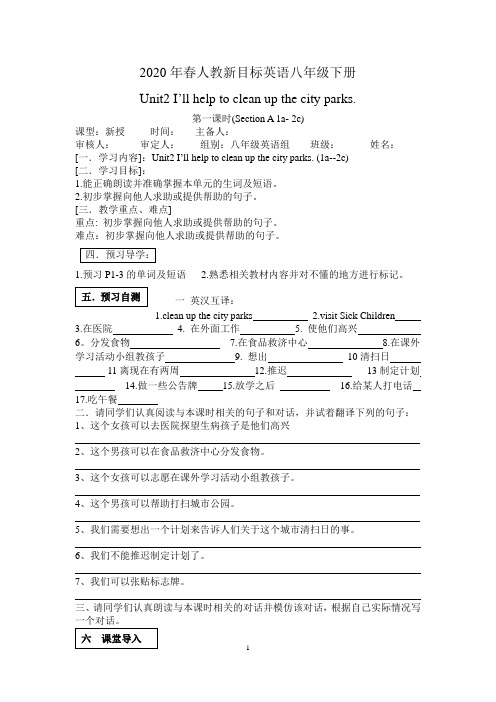
2020年春人教新目标英语八年级下册Unit2 I’ll help to clean up the city parks.第一课时(Section A 1a- 2c)课型:新授时间:主备人:审核人:审定人:组别:八年级英语组班级:姓名:[一.学习内容]:Unit2 I’ll help to clean up the city parks. (1a--2c)[二.学习目标]:1.能正确朗读并准确掌握本单元的生词及短语。
2.初步掌握向他人求助或提供帮助的句子。
[三.教学重点、难点]重点: 初步掌握向他人求助或提供帮助的句子。
难点:初步掌握向他人求助或提供帮助的句子。
1.预习P1-3的单词及短语2.熟悉相关教材内容并对不懂的地方进行标记。
一英汉互译:1.clean up the city parks2.visit Sick Children3.在医院4. 在外面工作5. 使他们高兴6。
分发食物7.在食品救济中心_____8.在课外学习活动小组教孩子9. 想出10清扫日______ 11离现在有两周_____12.推迟13制定计划__ ____ 14.做一些公告牌15.放学之后16.给某人打电话17.吃午餐二.请同学们认真阅读与本课时相关的句子和对话,并试着翻译下列的句子:1、这个女孩可以去医院探望生病孩子是他们高兴2、这个男孩可以在食品救济中心分发食物。
3、这个女孩可以志愿在课外学习活动小组教孩子。
4、这个男孩可以帮助打扫城市公园。
5、我们需要想出一个计划来告诉人们关于这个城市清扫日的事。
6、我们不能推迟制定计划了。
7、我们可以张贴标志牌。
三、请同学们认真朗读与本课时相关的对话并模仿该对话,根据自己实际情况写一个对话。
让学生小组回忆以前所学的有关于委婉(一)教学步骤1. 解读学习目标,学习新词汇2.教师通过玩游戏”Touch your ---”,然后引出询问向他人求助或提供帮助的句子:A: I like reading books.What could you do? B:You could volunteerin an after-school study program to teach kids. (选出写的好的小组进行加分)并核查预习案3.给学生5分钟的时间,让他们模仿1a中的短语进行相互问答练习并把他们编的对话写下来,听听力完成1 b,然后进行相互问答练习。
2020春人教版八年级英语下册教案设计:Unit 2 Section B(2a-2e)
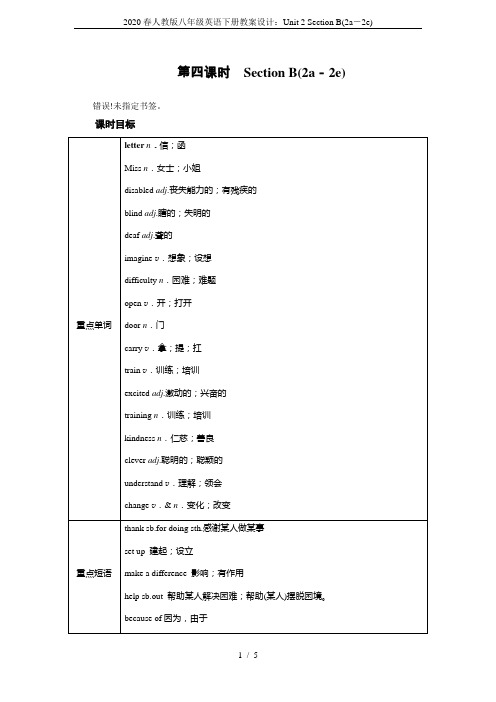
第四课时Section B(2a-2e)错误!未指定书签。
课时目标错误!未指定书签。
自主学习一、根据句意及汉语提示写出单词。
1.We should try our best to help disabled(残疾的)people.2.A blind(失明的)person can not see anything.3.I can hardly imagine(想象)such a scene.4.Jack is brave enough to face all the difficulties(困难).5.I am excited(激动的)about the idea of climbing mountains this weekend.二、写出下列画线短语的汉语意思。
1.I’m sure you know that this group was set up to help disabled people like me.建起;设立2.Lucky makes a big difference to my life.对……产生重大影响3.Then one day last year,a friend of mine helped me out.帮助……解决困难错误!未指定书签。
教学过程环节1新课导入1.Greetings.2.Ask students to look at the two pictures.Question:What can you do to help them?设计意图:以情境导入和图片展示的直观形式进行教学,引入本课时的话题,能够迅速抓住学生的眼球,激起学生的学习兴趣。
环节2学习2a-2e1.结对练习。
学生两人一组,讨论自己一般是怎么感谢他人帮助的。
教师邀请几名学生分享自己的观点。
2.让学生快速浏览2b中信的内容,掌握其主旨大意。
3.让学生浏览2b的两个问题,然后带着问题再次阅读短文,完成练习。
八年级英语下册(人教版)Unit2单元整体优秀教学案例
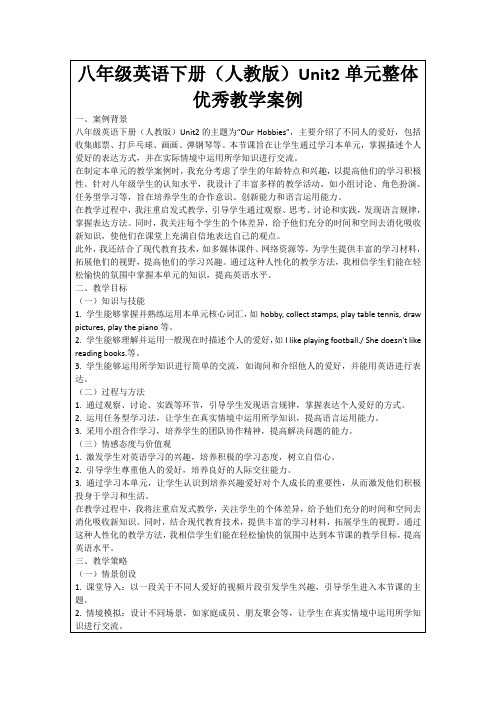
(一)导入新课
1.课堂起始,我将以一个有趣的问题引导学生思考:“同学们,你们有自己的爱好吗?能分享一下吗?”让学生自由发言,谈论自己的兴趣爱好。
2.紧接着,我会展示一段关于不同人爱好的视频片段,如收集邮票、打乒乓球、画画等,引导学生关注本节课的主题。
3.然后,我会向学生介绍本节课的学习目标,让他们明确本节课需要掌握的知识和技能。
二、教学目标
(一)知识与技能
1.学生能够掌握并熟练运用本单元核心词汇,如hobby, collect stamps, play table tennis, draw pictures, play the piano等。
2.学生能够理解并运用一般现在时描述个人的爱好,如I like playing football./ She doesn't like reading books.等。
2.合作完成任务:学生分组完成相关任务,如制作关于爱好的海报、编写对话等。
3.小组互评:学生相互评价,给出建议和意见,共同提高。
(四)反思与评价
1.学生自我反思:让学生回顾本节课的学习过程,总结自己的收获和不足。
2.同伴评价:学生相互评价,给出建议和意见,促进共同进步。
3.教师评价:教师对学生的学习过程和成果进行评价,给予鼓励和指导。
(二)讲授新知
1.通过PPT展示本节课的核心词汇,如hobby, collect stamps, play table tennis等,并引导学生跟读,确保他们正确掌握这些词汇。
2.接着,我会运用一般现在时引导学生描述个人爱好,如“I like playing football.”“She doesn't like reading books.”等,并让学生进行模仿练习。
人教版八年级英语学案unit2_How_often_do_you_exercise

二、根据句意,从括号中选择正确的单词填空。
1. My grandpa learns English(for; of) an hour every day.
2. Maria spent(on; about) two hours on her homework this afternoon.
3. Jack goes to the swimming club(one; once) a week.
4. It’s(time; times) for us to go to school.
5. Anna goes to visit her grandma four(time; times) a month.
【训练案】
一、根据句意,用括号内所给词的适当形式填空。
1. My mother goes to Beijing__________ (two) a year.
2. I__________ (hard) ever see him now.
3. Do you want to go ______________ (skateboard) with me?
1. I also like English. But math is my f____________ subject.
2. Her uncle n___________ watches football match. He doesn’t like football at all.
3. -- What is your favorite TV p_________? -- Sports news.
新人教版八年级英语下册Unit2-I'll-help-to-clean-up-the-city-parks教案
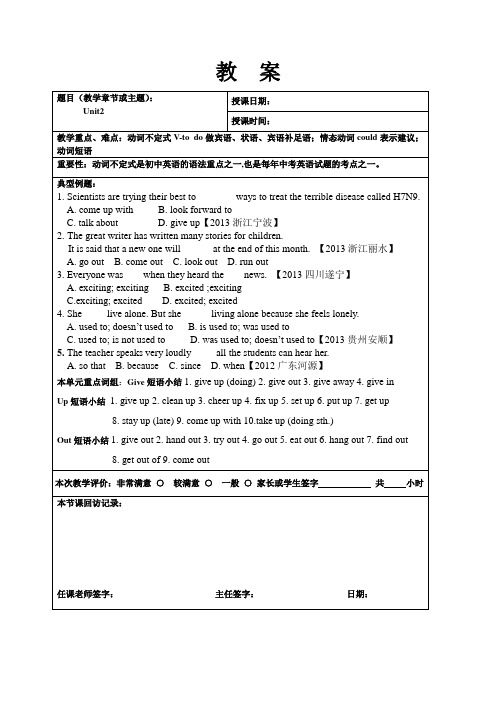
教案讲义学生:任课教师:例:Several boys were injured. 有几个小伙子伤了。
My friend speaks several languages. 我的朋友能讲几种语言11. Last year, she decided to try out for a volunteer after-school reading program.去年,她决定尝试在一个课后阅读项目中做一名志愿者。
【解析】try out 尝试;实验【拓展】try on 试穿①We should __________________(尽最大努力)to be happy in the future.②We should try ___ much fruit.A. eatB. to eatC. eatingD. eats12. care for sb./sth.照顾;照料care【名词】小心,关心;take care of = look after →【动词】care about sb./sth.关心,在意某人/事例:Many students in our school _______ the old and they usually offer their seats to them on buses. A.worry about B. care for C. agree with D. take care【拓展】care的短语总结take care =be careful v.当心,小心;take care of =look after v.照顾,照料,照看take care of 处理,做完练习:Thanks for your invitation, but I’m so sorry I can’t go. I need to ______ my baby at home. A. take away B. take off C. take care of D. take out of13. But I want to learn more about how to care for animals...但是我想学习更多的关于如何照顾动物的知识【解析】―疑问词+不定式‖作及物动词的宾语,【记】:I don’t know what to do.I don’t know how to do it. I don’t know what to do with it.【拓展】v+up with构成的短语:catch up with赶上;追上;put u with容忍;忍得住;keep up with 跟上;跟、保持联系end up with 结束;以.......而结束17.They told me stories about the past and how things used to be.他们给我讲过去的故事,并告诉我过去事情是什么样子的。
人教版新目标八年级英语第2单元Unit2教案
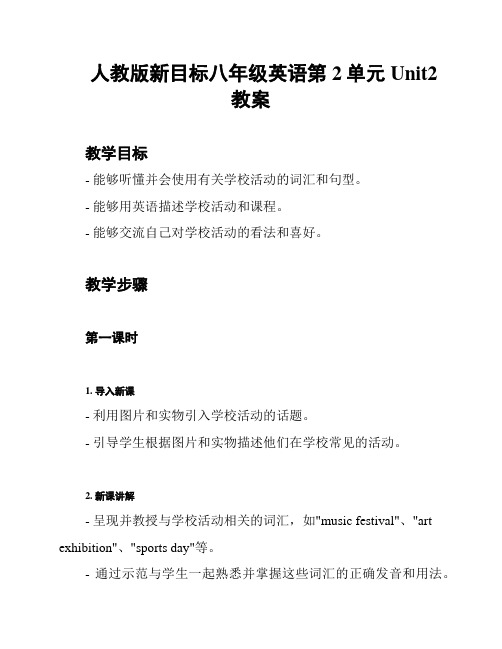
人教版新目标八年级英语第2单元Unit2教案教学目标- 能够听懂并会使用有关学校活动的词汇和句型。
- 能够用英语描述学校活动和课程。
- 能够交流自己对学校活动的看法和喜好。
教学步骤第一课时1. 导入新课- 利用图片和实物引入学校活动的话题。
- 引导学生根据图片和实物描述他们在学校常见的活动。
2. 新课讲解- 呈现并教授与学校活动相关的词汇,如"music festival"、"art exhibition"、"sports day"等。
- 通过示范与学生一起熟悉并掌握这些词汇的正确发音和用法。
- 操练这些词汇,并与学生一起编制句子来描述学校活动。
3. 听力训练- 播放关于学校活动的对话,要求学生仔细听并选择正确的图片。
- 学生互相对话,讨论听到的对话内容。
4. 对话练- 分组或两人一组,让学生模仿对话,表演关于学校活动的场景。
- 鼓励学生用英语进行自由对话,并互相分享自己参与过的学校活动。
5. 作业布置- 课堂分发作业卷,要求学生写一篇短文,介绍自己最喜欢的学校活动,并陈述原因。
第二课时1. 短文分享- 学生轮流与同桌分享自己写的短文。
- 鼓励其他学生提出问题或表达对短文的意见和建议。
2. 阅读训练- 学生阅读一篇关于学校活动的短文,并回答相关问题。
- 教师引导学生理解短文的内容,帮助他们解决阅读中遇到的问题。
3. 语法讲解- 教授句子结构"What do you think of + 学校活动?"和相应的答语。
- 帮助学生理解并掌握这种句子结构的用法。
4. 语法练- 学生分组或两人一组,互相提问"What do you think of + 学校活动?"并回答对方。
- 引导学生用所学词汇和句型互相交流和讨论自己对学校活动的看法和喜好。
5. 总结课堂内容- 教师带领学生回顾本节课所学的词汇、句型和语法。
人教版八年级下册英语Unit2Section A 第2课时(3a~4c)教案与反思
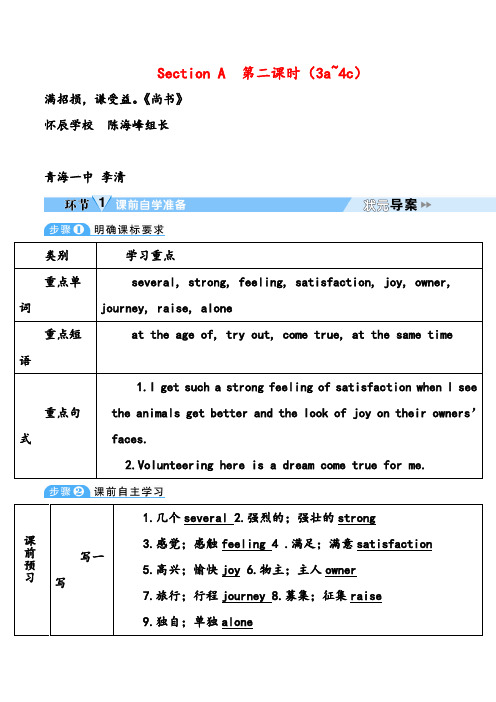
Section A 第二课时(3a~4c)满招损,谦受益。
《尚书》怀辰学校陈海峰组长青海一中李清类别学习重点重点单词several, strong, feeling, satisfaction, joy, owner, journey, raise, alone重点短语at the age of, try out, come true, at the same time重点句式1.I get such a strong feeling of satisfaction when I see the animals get better and the look of joy on their owners’faces.2.Volunteering here is a dream come true for me.课前预习写一写1.几个several2.强烈的;强壮的strong3.感觉;感触feeling 4 .满足;满意satisfaction5.高兴;愉快joy6.物主;主人owner7.旅行;行程journey 8.募集;征集raise9.独自;单独alone译一译1.参加……选拔;试用try out2.(希望、梦想等)成真come true3.同时at the same time背一背1.当我看到动物们(病情)渐好,看到它们主人脸上的喜悦表情时,我产生出那么一种极强的满足感。
I get such a strong feeling of satisfaction when I see the animals get better and the look of joy on their owners’faces.2.在这里当志愿者对我来说是梦想成真。
Volunteering here is a dream come true for me.新课导入Teacher:Do you want to volunteer to do something? What kind of work do you want to do? Today we will learn an artice. It’s about the student who volunteer. Let’s read it to find out what they volunteer to do.例句:He s busy doig his homeork.= He is busy with his homework.他正忙着做家庭作业。
【最新】人教版八年级英语下册Unit 2 教案

Unit 2 I’ll help clean up the city parks教案Part 1: Teaching design (第一部分:教学设计)SECTION AGoals●To learn to use p hrasal verbs●To read about being a volunteer●To listen and talk about clean up the city parksProceduresWarming up by learning about grammar focusHello, class. This week we shall go and help clean up the city parks. But first what is the meaning of “clean up”? What verb is it?Turn to page 61 and look at the chart to learn about “phrasal verb”What is a phrasal verb?▲It is an English verb followed by one or more particles where the combination behaves as a syntactic and semantic unit; “turn out” is a phrasal verb in the question “how many turned out to vote?”▲In the English language, a phrasal verb is a verb combined with a preposition, an adverb, or an adverbial particle, all three of which are uninflected.1a Looking and readingLook at the bulletin board on page 60 and read about ways by which you could help people. Then list other ways you could help people.1b Listening and completingYou are going to listen to several conversations.While listening, pay attention to information to complete the sentences on page 60 in the box.1c Doing pairworkIn pairs you are to practice the conversations in the picture on page 60. Then make similar conversations using the information in activity 1b.We could help stop hunger by giving out food2a Listening and checkingSome students talking about planning a City Parks Clean-up Day. Listen to their talk and check√the things they are going to do.2b Listening and filling in blanksI’ shall play t he tape again and you are to listen and fill in the blanks in the box on 61.2c Doing pairworkLet’s go on to role play the conversation in activity 2b.3a Reading, underlining and circlingOn page 62 is an article about volunteers. Read it and underline the kinds of work they do. YouRead the article again to darken the phrasal verbs found in it.3b Filling in the tableOn page 62 is a table showing the kinds of volunteer work the four students could do. Read thetable and fill in it.3c Doing pairNext take turns role playing being one of the people in 3b by asking and giving advice.4 Doing pairworkIn the table on bottom of page 62 write down three things you like to do and then ask your partner for advice about the kinds of volunteer work you could do.Closing down by reading an English poemFalling Asleep in ClassI fell asleep in class today,as I was awfully bored.I laid my head upon my deskand closed my eyes and snored.I woke to find a piece of papersticking to my face.I'd slobbered on my textbooksand my hair was a disgrace.My clothes were badly rumpledand my eyes were glazed and red.My binder left a three-ringindentation in my head.I slept through class, and probablyI would have slept some more,except my students woke meas they headed out the door.Kenn NesbittSECTION B●To Learn more phrasal verbs●To listen, speak and write using phrasal verbsProceduresWarming up by brainstorming phrasal verbsHello, everyone. To begin with, we shall brainstorm a list of phrasal verbs.On page 63 is a box with 4 sentences. Match them with their similar meanings on the right.1b Making sentencesOn page 63 you will find a box with some phrasal verbs. Make a sentence with each of the phrasalverbs.2a Listening and numberingListen to the recording that I am going to play and number the pictures on page 63. (Key:a4,b2,c1,d3 )2b Listening and circlingYou shall listen to the recording again to circle “T” or “F”.2c Doing pairworkIn pairs practice the conversations between Jmmy and the reporter. Use the information from the activities on page 63.3a Reading and underliningOn page 64 is an article about Jimmy the Bike Boy. Read to understand it and underline all the phrasal verbs.Copy all the phrasal verbs and useful expressions onto your notebook.3b Making a noteRead the article again to make a note of the things that Jimmy did in order to sole his problem.1.He did a radio interview.2.He also put up some signs asking for old bikes.3.He called up all his friends and told them about the problem.4.He even handed out advertisements at a local supermarket.5.He told the teachers at school about his problem and they set up a call-in center for parents.4 Doing groupworkBy brainstorming work out a plan for helping out in your community. Write down where and what you will volunteer and tell your classmates about your plan.Closing down by talking about volunteer workLook at the pictures below and talk about the volunteer work that the people in the pictures aredoing.SELF CHECK1.Filling and makingTurn to page 65 and fill in the blank with a correct word given in its correct form. Then make a sentence with each of the given words.2 Writing an article tell about SallyOn page 65 is a box with words and phrases. Write an article telling about what happens to Sally.Just for funLook at the pictures and make a storyout of them.Reading: I’ll send you a photo ofLucky.Before you read, listen to the recording without looking at the article.While you read,underline all the phrasal verbs, blacken all the expressions all the linking words.After you read, copy down all the phrasal verbs and useful expressions into your notebook.Part 2: Teaching Resources (第二部分:教学资源)I. What is a volunteer?A volunteer is someone who performs or offers to perform a service out of his own free will, oftenwithout payment. The year 2001 was the International Year of the Volunteer. 2005 is the UK Year of the Volunteer.People may volunteer to perform some work, e.g., of charitable character. Some volunteer for clinical trials or other medical research, and may even donate their bodies to science after their death.II. What is an online Volunteer?An online volunteer is a person who contributes time and effort with an organization through an online connection, rather than in person. A wide variety of people from around the world are online volunteers and most are not technology professionals.Online volunteers may provide advice, consultancy and perform remote administration tasks for the organisation, usually a charity or non-profit organisation. The practice of donating time online goes by other names, such as virtual volunteering, cyber service, telementoring, e-volunteering, and cyber volunteering.There are many opportunities for people to donate their services using the internet. Online volunteers do a variety of tasks, such as translating documents, editing or preparing proposals, designing logos, researching information, developing strategic plans, reviewing budgets, creating web pages, designing flash presentations, moderating online discussion groups and managing other online volunteers.III. What is an ICT Volunteer?An ICT volunteer is someone who is working to foster the implementation and use of Information and Communication Technologies. He or she can install hardware, software or carry on with ICT training programmes. There is no need to be an online volunteer to be an ICT volunteer: installing hardware is a good example. Likewise, there is no need to be an ICT volunteer to be an online volunteer: teaching a language through a virtual campus is not related with ICT fostering, at least in a direct way.....。
人教版初中八年级英语下册第二单元Unit 2 教案含教学反思

Section A 单词cheer v.欢呼;喝彩volunteer v.义务做;自愿做n.志愿者sign n.标志;信号notice n.通知;通告;注意v.注意到;意识到lonely adj.孤独的;寂寞的several pron.几个;数个;一些strong adj.强烈的;强壮的feeling n.感觉;感触satisfaction n.满足;满意joy n.髙兴;愉快owner n.物主;主人journey n.(尤指长途)旅行;行程raise v.募集;征集alone adv.独自;单独midnight n.午夜;子夜短语clean up打扫(或清除)干净cheer up (使)变得更高兴;振奋起来give out分发;散发come up with想出;提出(主意、计划、回答等)put off推迟hand out 分发call up打电话给(某人);征召used to曾经……;过去……care for照顾;非常喜欢try out参加……选拔;试用句型1.They told me stories about the past and how things used to be.他们给我讲过去的生活经历,讲过去是什么样子的。
2.…but I want to learn more about how to care for animals.……但是我想更多地了解如何照料动物。
句型1.I’m sure you know that this group was set up to help disabled people like me.我确定你知道这个团体是为了帮助像我这样的残疾人而建立的。
2.You helped to make it possible for me to have Lucky.有了你的帮助,我才有可能拥有“幸运儿”。
3.I’ll send you a photo of him if you like,and I could show you how he helps me.如果你喜欢,我会把它的一张照片寄给你,并可以让你看看它是怎样帮助我的。
Unit2 教案2021-2022 学年人教版八年级下册英语
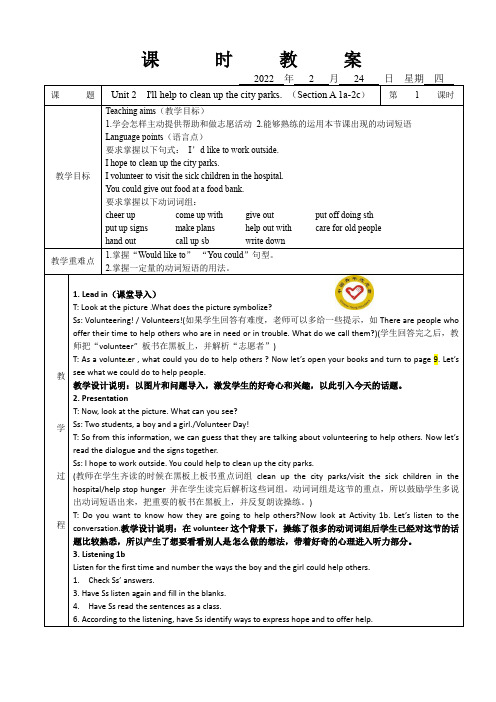
课时教案2022 年 2 月24 日星期四课题Unit 2 I'll help to clean up the city parks. (Section A 1a-2c)第 1 课时教学目标Teaching aims(教学目标)1.学会怎样主动提供帮助和做志愿活动2.能够熟练的运用本节课出现的动词短语Language points(语言点)要求掌握以下句式:I’d like to work outside.I hope to clean up the city parks.I volunteer to visit the sick children in the hospital.You could give out food at a food bank.要求掌握以下动词词组:cheer up come up with give out put off doing sthput up signs make plans help out with care for old peoplehand out call up sb write down教学重难点1.掌握“Would like to”“You could”句型。
2.掌握一定量的动词短语的用法。
教学过程1. Lead in(课堂导入)T: Look at the picture .What does the picture symbolize?Ss: Volunteering! / Volunteers!(如果学生回答有难度,老师可以多给一些提示,如There are people who offer their time to help others who are in need or in trouble. What do we call them?)(学生回答完之后,教师把“volunteer” 板书在黑板上,并解析“志愿者”)T: As a volunte er , what could you do to help others ? Now let’s open your books and turn to page 9. Let’s see what we could do to help people.教学设计说明:以图片和问题导入,激发学生的好奇心和兴趣,以此引入今天的话题。
新目标人教版八年级英语下Unit2全单元教案
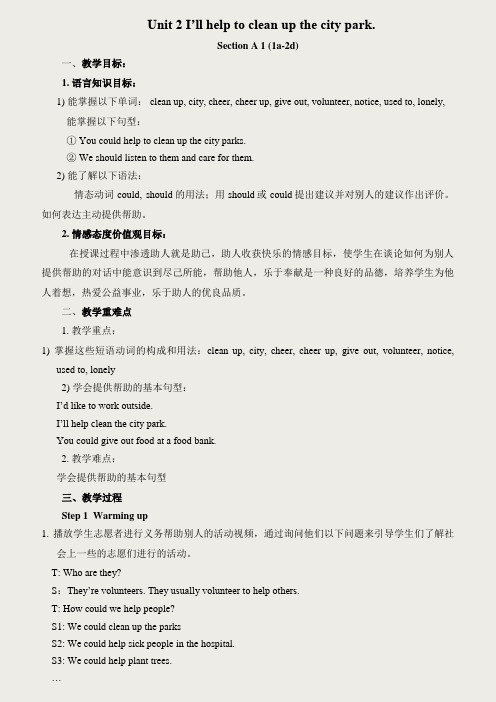
Unit 2 I’ll help to clean up the city park.Section A 1 (1a-2d)一、教学目标:1. 语言知识目标:1) 能掌握以下单词: clean up, city, cheer, cheer up, give out, volunteer, notice, used to, lonely,能掌握以下句型:① You could help to clean up the city parks.② We should listen to them and care for them.2) 能了解以下语法:情态动词could, should的用法;用should或could提出建议并对别人的建议作出评价。
如何表达主动提供帮助。
2. 情感态度价值观目标:在授课过程中渗透助人就是助己,助人收获快乐的情感目标,使学生在谈论如何为别人提供帮助的对话中能意识到尽己所能,帮助他人,乐于奉献是一种良好的品德,培养学生为他人着想,热爱公益事业,乐于助人的优良品质。
二、教学重难点1. 教学重点:1) 掌握这些短语动词的构成和用法:clean up, city, cheer, cheer up, give out, volunteer, notice,used to, lonely2) 学会提供帮助的基本句型:I’d like to work outside.I’ll help clean the city park.You could give out food at a food bank.2. 教学难点:学会提供帮助的基本句型三、教学过程Step 1 Warming up1. 播放学生志愿者进行义务帮助别人的活动视频,通过询问他们以下问题来引导学生们了解社会上一些的志愿们进行的活动。
T: Who are they?S:They’re volunteers. They usually volunteer to help others.T: How could we help people?S1: We could clean up the parksS2: We could help sick people in the hospital.S3: We could help plant trees.…Step 2 New words1. city n.城市e.g. The library is in the north of the city. 图书馆在城市的北部。
(完整版)新人教版八年级下册英语全册教案
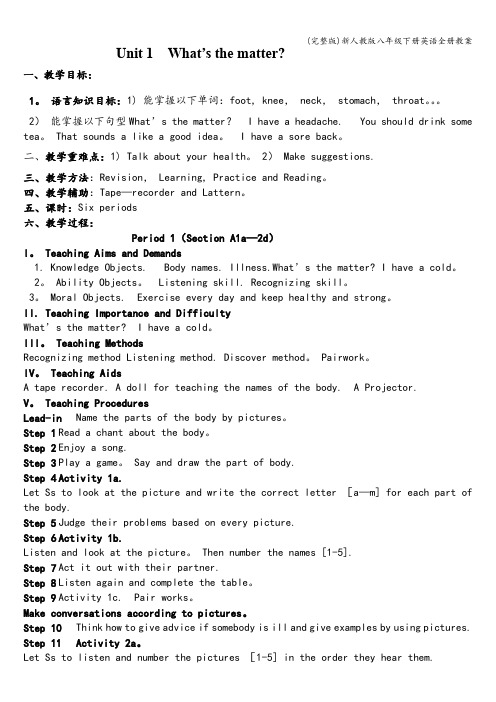
Unit 1 What’s the matter?一、教学目标:1。
语言知识目标:1) 能掌握以下单词:foot, knee, neck, stomach, throat。
2)能掌握以下句型What’s the matter? I have a headache. You should drink some tea。
That sounds a like a good idea。
I have a sore back。
二、教学重难点:1) Talk about your health。
2) Make suggestions.三、教学方法:Revision, Learning, Practice and Reading。
四、教学辅助:Tape—recorder and Lattern。
五、课时:Six periods六、教学过程:Period 1(Section A1a—2d)I。
Teaching Aims and Demands1. Knowledge Objects. Body names. Illness.What’s the matter? I have a cold。
2。
Ability Objects。
Listening skill. Recognizing skill。
3。
Moral Objects. Exercise every day and keep healthy and strong。
II. Teaching Importance and DifficultyWhat’s the matter? I have a cold。
III。
Teaching MethodsRecognizing method Listening method. Discover method。
Pairwork。
IV。
Teaching AidsA tape recorder. A doll for teaching the names of the body. A Projector.V。
新人教版八年级下册初中英语全册教案(教学设计)
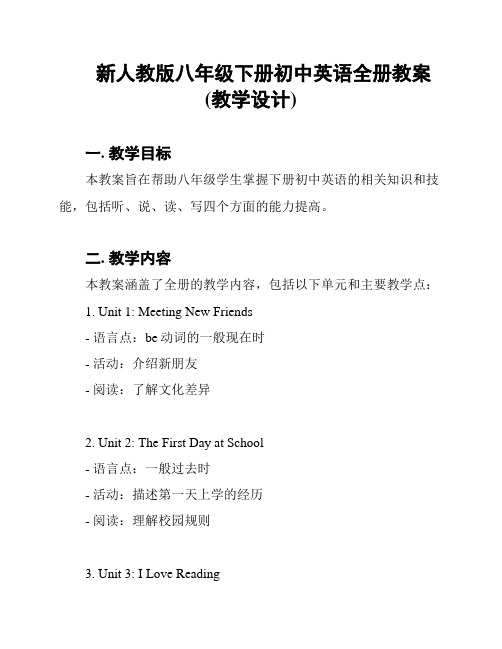
新人教版八年级下册初中英语全册教案(教学设计)一. 教学目标本教案旨在帮助八年级学生掌握下册初中英语的相关知识和技能,包括听、说、读、写四个方面的能力提高。
二. 教学内容本教案涵盖了全册的教学内容,包括以下单元和主要教学点:1. Unit 1: Meeting New Friends- 语言点:be动词的一般现在时- 活动:介绍新朋友- 阅读:了解文化差异2. Unit 2: The First Day at School- 语言点:一般过去时- 活动:描述第一天上学的经历- 阅读:理解校园规则3. Unit 3: I Love Reading- 语言点:情态动词can和must - 活动:介绍喜欢的书籍- 阅读:阅读理解4. Unit 4: My School Life- 语言点:形容词比较级和最高级- 活动:描述学校生活的不同方面- 阅读:了解不同的学校生活5. Unit 5: Our Future Jobs- 语言点:职业相关词汇- 活动:谈论未来的职业- 阅读:了解不同的职业6. Unit 6: Weather and Climate- 语言点:天气相关词汇和短语- 活动:讨论天气和气候- 阅读:了解不同地区的气候7. Unit 7: Enjoy Your Trip- 语言点:旅行相关词汇和短语- 活动:计划和描述旅行- 阅读:阅读旅行指南8. Unit 8: At the Farm- 语言点:动词的现在进行时- 活动:描述在农场的经历- 阅读:了解农场生活三. 教学方法本教案使用多种教学方法,包括但不限于:听力练、口语对话、阅读理解、小组讨论、写作练等。
教师将根据具体情况选择合适的教学方法进行教学。
四. 教学步骤1. 引入新课,激发学生兴趣。
2. 执行听力练以提高学生听力能力。
3. 进行口语对话练,帮助学生提高口语表达能力。
4. 进行阅读理解练,加深学生对课文的理解。
5. 进行小组讨论,让学生互相交流观点。
人教版八年级英语下册第二单元集体备课
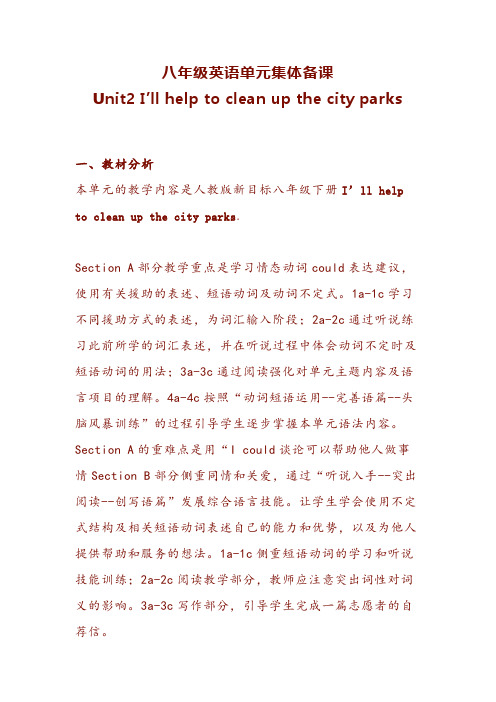
八年级英语单元集体备课Unit2 I’ll help to clean up the city parks一、教材分析本单元的教学内容是人教版新目标八年级下册I’ll help to clean up the city parks.Section A部分教学重点是学习情态动词could表达建议,使用有关援助的表述、短语动词及动词不定式。
1a-1c学习不同援助方式的表述,为词汇输入阶段;2a-2c通过听说练习此前所学的词汇表述,并在听说过程中体会动词不定时及短语动词的用法;3a-3c通过阅读强化对单元主题内容及语言项目的理解。
4a-4c按照“动词短语运用--完善语篇--头脑风暴训练”的过程引导学生逐步掌握本单元语法内容。
Section A的重难点是用“I could谈论可以帮助他人做事情Section B部分侧重同情和关爱,通过“听说入手--突出阅读--创写语篇”发展综合语言技能。
让学生学会使用不定式结构及相关短语动词表述自己的能力和优势,以及为他人提供帮助和服务的想法。
1a-1c侧重短语动词的学习和听说技能训练;2a-2c阅读教学部分,教师应注意突出词性对词义的影响。
3a-3c写作部分,引导学生完成一篇志愿者的自荐信。
二、学情分析:话题背景:本单元围绕“志愿者工作”这一话题展开,非常贴近学生实际生活。
经过3月5号学雷锋活动学生会有话可说并非常感兴趣。
知识背景:七年级情态动词can用法的学习、第一单元情态动词should陈述建议,已为本单元学习could表达建议打下语法基础.八年级上册第五单元已学过动词不定式做宾语,本单元将补充不定式作状语、宾补等用法。
短语动词则渗透到日常教学活动中。
大三、教学目标:本单元的教学目标:1、通过听说训练,能够用目标语言谈论帮助他人并交流参加志愿活动的感受。
2、能熟练运用不定式,用所学动词短语表达自己的想法。
3、根据问题,从听力或短文中快速获取信息。
4、通过学习志愿者帮助别人故事,激发孩子们积极参与做志愿者活动对学生进行情感上的教育。
人教版八年级下册英语教案(全册)
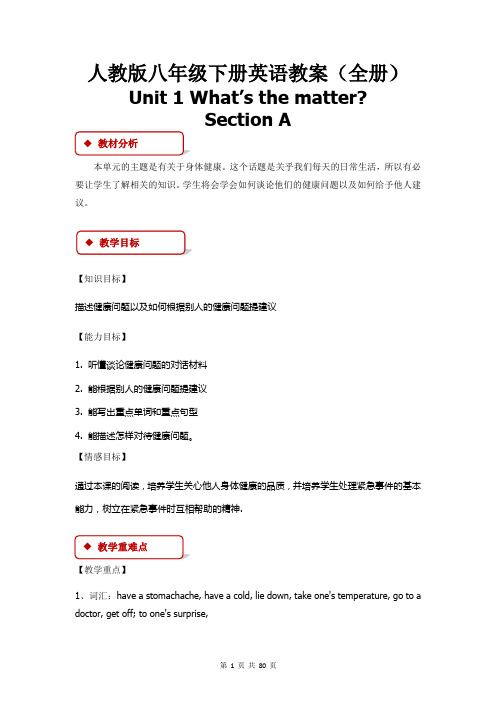
人教版八年级下册英语教案(全册)Unit 1 What’s the matter?Section A◆教材分析本单元的主题是有关于身体健康。
这个话题是关乎我们每天的日常生活,所以有必要让学生了解相关的知识。
学生将会学会如何谈论他们的健康问题以及如何给予他人建议。
◆教学目标【知识目标】描述健康问题以及如何根据别人的健康问题提建议【能力目标】1.听懂谈论健康问题的对话材料2.能根据别人的健康问题提建议3.能写出重点单词和重点句型4.能描述怎样对待健康问题。
【情感目标】通过本课的阅读,培养学生关心他人身体健康的品质,并培养学生处理紧急事件的基本能力,树立在紧急事件时互相帮助的精神.◆教学重难点◆【教学重点】1、词汇:have a stomachache, have a cold, lie down, take one's temperature, go to a doctor, get off; to one's surprise,2、句型:1. ——What's the matter?——I have a stomachache. You shouldn't eat so much next time.2 . ——What's the matter with Ben?——He hurt himself. He has a sore back.——He should lie down and rest.【教学难点】掌握情态动词should shouldn't.的用法;学习have的用法◆课前准备◆Multimedia, group work, cooperative discussion.◆教学过程Step1. Warm up1. Look at the picture and learn the parts of the body.2. New words and phrases.Step 2 Presentation1. 1aLook at the picture. Write the correct letter [a-m] for each part of the body. Then check the answers.2. 1bFirst, lead Ss to read the five names.Then look at the picture. Number the names 1-5.Finally, check the answers.3. 1cDivide two Ss into a pair to make conversations. Finally, invite several pairs to act out for the class.Step 3 Practice1. 2aTell Ss there are five conversations. In each conversation the person says what’s going on with them. Listen carefully and number the pictures.Play the tape. Then check the answers.2. 2bAsk Ss to listen to the recording again to match the problems with the advice.Play the recording again. Then check the answers.3. 2cAsk Ss to make conversations using the information in 2a and2b. Give them enough time to do this task. Later, invite several pairs to present their conversations to the class.Step 4 Consolidation1. 2dFirst, ask Ss to have a fast reading of the conversation to get the main idea.Then, lead Ss to read the conversation sentence by sentence, explain some language points.Finally, divide Ss into pairs to practice role-playing the conversation.2. 3aFirst, read the passage quickly and answer the question.Then, lead Ss to read the passage and analyse the key points.Finally, read together.3. 3bRead the passage again and check the things that happened in the story3cDiscuss the questions with a partner.4. Grammar focusFirst, lead Ss to read the sentences.Then, prompt Ss to analyse the use of model verb should.After that, explain the grammar together.5. 4aAsk Ss to fill in the blanks.Then , invite some Ss to present their answers.6. 4bAsk Ss to circle the best advice for these health problems, then add their own advice.After that, invite some Ss to present their advice.7. 4cOne student mimes a problem. The other students in your group guess the problem and give advice.Step 5 Language pointsStep 6 HomeworkMake a conversation about health problems and giving advice.Unit 1 What’s the matter?Section B◆教材分析本单元的主题是有关于身体健康。
人教版新目标八年级下册英语教案:Unit2WhatshouldIdo?
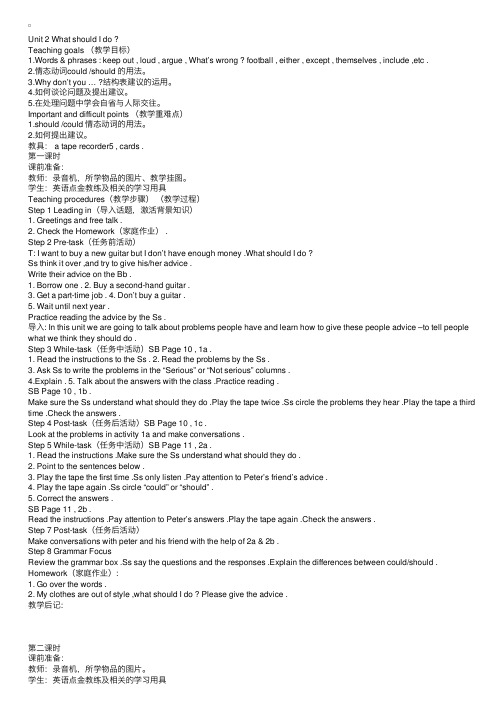
Unit 2 What should I do ?Teaching goals (教学⽬标)1.Words & phrases : keep out , loud , argue , What’s wrong ? football , either , except , themselves , include ,etc .2.情态动词could /should 的⽤法。
3.Why don’t you … ?结构表建议的运⽤。
4.如何谈论问题及提出建议。
5.在处理问题中学会⾃省与⼈际交往。
Important and difficult points (教学重难点)1.should /could 情态动词的⽤法。
2.如何提出建议。
教具: a tape recorder5 , cards .第⼀课时课前准备:教师:录⾳机,所学物品的图⽚、教学挂图。
学⽣:英语点⾦教练及相关的学习⽤具Teaching procedures(教学步骤)(教学过程)Step 1 Leading in(导⼊话题,激活背景知识)1. Greetings and free talk .2. Check the Homework(家庭作业) .Step 2 Pre-task(任务前活动)T: I want to buy a new guitar but I don’t have enough money .What should I do ?Ss think it over ,and try to give his/her advice .Write their advice on the Bb .1. Borrow one .2. Buy a second-hand guitar .3. Get a part-time job .4. Don’t buy a guitar .5. Wait until next year .Practice reading the advice by the Ss .导⼊: In this unit we are going to talk about problems people have and learn how to give these people advice –to tell people what we think they should do .Step 3 While-task(任务中活动)SB Page 10 , 1a .1. Read the instructions to the Ss .2. Read the problems by the Ss .3. Ask Ss to write the problems in the “Serious” or “Not serious” columns .4.Explain .5. Talk about the answers with the class .Practice reading .SB Page 10 , 1b .Make sure the Ss understand what should they do .Play the tape twice .Ss circle the problems they hear .Play the tape a third time .Check the answers .Step 4 Post-task(任务后活动)SB Page 10 , 1c .Look at the problems in activity 1a and make conversations .Step 5 While-task(任务中活动)SB Page 11 , 2a .1. Read the instructions .Make sure the Ss understand what should they do .2. Point to the sentences below .3. Play the tape the first time .Ss only listen .Pay attention to Peter’s friend’s advice .4. Play the tape again .Ss circle “could” or “should” .5. Correct the answers .SB Page 11 , 2b .Read the instructions .Pay attention to Peter’s answers .Play the tape again .Check the answers .Step 7 Post-task(任务后活动)Make conversations with peter and his friend with the help of 2a & 2b .Step 8 Grammar FocusReview the grammar box .Ss say the questions and the responses .Explain the differences between could/should . Homework(家庭作业):1. Go over the words .2. My clothes are out of style ,what should I do ? Please give the advice .教学后记:第⼆课时课前准备:教师:录⾳机,所学物品的图⽚。
新人教版初中英语八年级下册Unit2教案
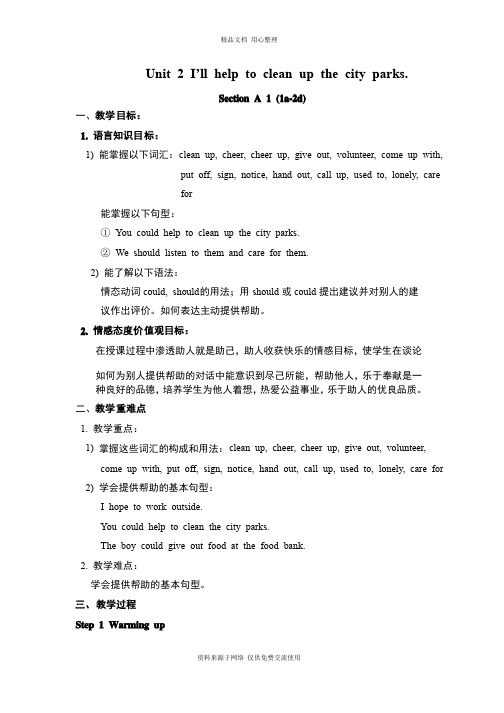
Unit 2 I’ll help to clean up the city parks.Section A 1 (1a-2d)一、教学目标:1. 语言知识目标:1) 能掌握以下词汇:clean up, cheer, cheer up, give out, volunteer, come up with, put off, sign, notice, hand out, call up, used to, lonely, care for 能掌握以下句型:① You could help to clean up the city parks. ② We should listen to them and care for them. 2) 能了解以下语法:情态动词could, should 的用法;用should 或could 提出建议并对别人的建议作出评价。
如何表达主动提供帮助。
2. 情感态度价值观目标:在授课过程中渗透助人就是助己,在授课过程中渗透助人就是助己,助人收获快乐的情感目标,助人收获快乐的情感目标,助人收获快乐的情感目标,使学生在谈论使学生在谈论如何为别人提供帮助的对话中能意识到尽己所能,如何为别人提供帮助的对话中能意识到尽己所能,帮助他人,帮助他人,乐于奉献是一种良好的品德,培养学生为他人着想,热爱公益事业,乐于助人的优良品质。
二、教学重难点m1. 教学重点:1) 掌握这些词汇的构成和用法:clean up, cheer, cheer up, give out, volunteer, come up with, put off, sign, notice, hand out, call up, used to, lonely, care for 2) 学会提供帮助的基本句型:I hope to work outside. You could help to clean the city parks. The boy could give out food at the food bank. 2. 教学难点:学会提供帮助的基本句型。
- 1、下载文档前请自行甄别文档内容的完整性,平台不提供额外的编辑、内容补充、找答案等附加服务。
- 2、"仅部分预览"的文档,不可在线预览部分如存在完整性等问题,可反馈申请退款(可完整预览的文档不适用该条件!)。
- 3、如文档侵犯您的权益,请联系客服反馈,我们会尽快为您处理(人工客服工作时间:9:00-18:30)。
6.alone / lonely辨析:(1)alone = by oneself adj.单独的,指无人陪伴的客观事实
(2)lonely①指人孤独的,寂寞的,强调主观感受;②也可指某个地方是荒凉的
(二)、课堂检测:从方框中选择恰当的词组,并用其适当形式填空。
4. He _____(spend) every morning _______ (do)some sports.
5. They plan ___________ (buy) a big house.
(三)、拓展延伸:
(四)、课堂反思:
备注
Unit2Lesson2Section A 2a-2d
总课时编号:编写时间:月日执行时间:月日小组组别:
(一)、自主学习、合作探究:
一.回答问题:
1. Do you think volunteering is great?
2. What will you do if you are a volunteer? Please give some examples.
2.翻译下列词组:
1.打扫________ 2.分发________________ 3.使高兴;振奋____________
clean up, put up, cheer up, set up, come up with, give out ,put off, call up
1.He has a lot of work to do, so he has to _______________going to the doctor.
2)help作名词,“帮助”。如:______________________.谢谢你的帮助。
2. sick和ill的用法区别
sick是形容词,"生病的",同义词是ill。区别在于sick在句中可做语和____语,而ill只能做语。如:His father was /sick yesterday, so he didn't go to work. Tom has looked after the sick girl for a week.。当ill意为"坏的,恶劣的"时,在句中可做定语。如:He is an ill child.
自读、小组内互读单词和词组。
二、【合作探究】
(一)听读说训练:
1.一群学生正在策划一个城市公园清洁日。听录音,并勾出他们为告诉人们关于城市清洁日要做的事,完成2a。
2.朗读2b中的句子,再听一遍录音,并填空,完成2b。
3.用2a和2b中的信息编写对话,完成2c。
4.分角色表演对话,勾画出其中的重点短语,完成2d。
4.sick children 5.at the food bank 6.after-school study program
【合作探究】
一看课本1a,看图片中你能帮助别人的方式。然后列出其他方式,完成1a。
二听读说训练:
1.听一听,填一填,完成1b。
2.朗读1b,勾画有用的表达法: clean up;;cheer up; give out; at the food bank
(二)语言学习。
【解析】come up with =think up想出
【短语】:think about考虑think of想起think over仔细考虑
【谚语】Think before you act三思而后行
2. (1) use v.使用→useful adj.有用的use up用完
Studying English is__________(usห้องสมุดไป่ตู้).
小组组号:姓名:
一、学习目标:1.重点词汇用法及短语动词用法。
2.could向他人提建议,动词短语的区别
二、重点难点:could向他人提建议,动词短语的区别,角色扮演
三、学习流程:
(一)、自主学习、合作探究:
翻译下列词组:
想出_______ 2.推迟______ 3.张贴_____________分发_________ 5.打电话___________ 6.清洁日__________7.care for ___________ ed to____________ 9.help out_____________
(二)、课堂检测:
用所给词的适当形式填空。
1. Let’s cheer _________ (they)up, ok?
2. I’d like _____________ (visit)my English teacher tomorrow.
3. I’ll feel good about _______ (help)the old people.
2.Could you help me _________________ these new books?
3.Don’t worry. I’ll help ______________your room.
3.练习上面图片中的对话,然后使用1b中的信息编写对话,完成1c。
(三)语言学习
1. You could help to clean up the city parks.
1)help作动词,“帮助”。help sb.to do sth.意为:______________.
如:He often helps me to study English.
Unit2Lesson1Section A 1a-1c
总课时编号:编写时间:月日执行时间:月日小组组别:
小组组号:姓名:
一、学习目标:1.重点词汇用法及短语动词用法。
2.学会应用“I could…”、“I hope to…”等句型,向别人提供帮助。
二、重点难点:重点词汇用法及短语动词用法。
三、学习流程:
(2) use sth to do sth用某物做某事We use Internet __________(find) information.
(3) used to do sth过去常常做某事,表示过去做过的事现在已经不做,只用于过去时态。
(4) be /get used to doing sth习惯于做某事
